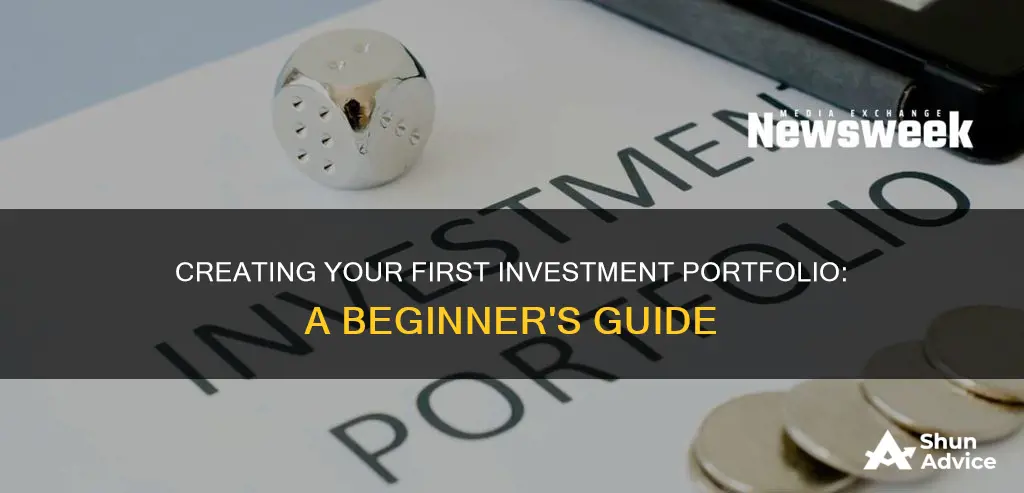
Creating your first investment portfolio can be a challenging task, but it is a crucial step towards achieving your financial goals. Here are the key steps to help you get started:
- Define your goals and time horizon: Determine your short-term and long-term financial objectives. Sort your goals based on how soon you will need the money, which can be categorised into short-term (within a year), medium-term (one to five years), and long-term (more than five years).
- Understand your risk tolerance: Assess how much risk you are comfortable taking on. Generally, a longer time horizon allows for a more aggressive approach with a higher allocation to stocks, while a shorter time horizon may require a more conservative strategy with a focus on capital preservation.
- Choose the right account type: Select an investment account that aligns with your goals. Tax-advantaged accounts like IRAs and 401(k)s are suitable for long-term retirement goals, while taxable brokerage accounts offer flexibility for mid to long-term goals.
- Select your investments: Decide on the types of investments that match your risk tolerance and goals. This includes stocks, bonds, mutual funds, exchange-traded funds (ETFs), and alternative investments like real estate or cryptocurrencies.
- Create your asset allocation: Determine how much of each investment type to include in your portfolio. Consider your risk tolerance, time horizon, and financial situation when allocating your assets.
- Diversify your portfolio: Diversification is key to managing risk. Spread your investments across different industries, sectors, and asset classes to reduce the impact of any single investment on your portfolio's performance.
- Monitor and rebalance: Regularly review your portfolio to ensure it remains aligned with your goals and risk tolerance. Adjust your holdings as necessary to maintain your desired asset allocation.
Remember, investing requires careful consideration and research. Consult reliable sources and, if needed, seek advice from qualified financial professionals to make informed decisions when creating your first investment portfolio.
| Characteristics | Values |
|---|---|
| First Step | Determining your goals and risk tolerance |
| Second Step | Understanding your risk tolerance |
| Third Step | Choosing an account type |
| Fourth Step | Selecting investments |
| Fifth Step | Creating your asset allocation and diversifying |
| Sixth Step | Monitoring, rebalancing and adjusting |
What You'll Learn

Determine your risk tolerance
Risk tolerance is the degree of risk that you, as an investor, are willing to take on. It is important to understand your risk tolerance before you start investing. Your risk tolerance will determine the type and amount of investments that you choose.
Factors Affecting Risk Tolerance
There are several factors that can affect your risk tolerance:
- Time horizon: The amount of time you plan to invest for. If you have a long time horizon, such as saving for retirement, you may be able to take on more risk. Conversely, if you have a shorter time horizon, such as saving for a down payment on a house, you may need to be more conservative.
- Financial goals: What are you investing for? If you are working towards a specific financial goal, such as buying a home or starting a business, you may opt for lower-risk investments to minimize potential losses.
- Personality: How do you feel about taking risks? Are you comfortable with uncertainty, or do you prefer a more stable approach? Your personality will play a role in determining your risk tolerance.
- Age: Your age can impact your risk tolerance. If you are younger, you may feel more comfortable taking on risk because you have more time to recover from any losses. On the other hand, if you are closer to retirement age, you may be more conservative with your investments.
- Income: Your income and future earning capacity will also affect your risk tolerance. If you have a higher income or other stable sources of funds, you may be able to take on more risk.
- Experience: Your level of investing experience is another factor to consider. If you are new to investing, you may want to start with a more cautious approach until you gain more knowledge and confidence.
Understanding Your Risk Tolerance
To understand your risk tolerance, you can ask yourself the following questions:
- How many years do you have until retirement?
- What are your specific investment goals?
- Are you comfortable with market volatility and potential short-term losses?
- Do you have non-invested savings and emergency funds?
- How closely do you plan to track your investments?
By considering these factors and assessing your risk tolerance, you can make more informed investment decisions and build a portfolio that aligns with your financial goals and comfort level.
Maximizing Your Extra Savings: Smart Investment Strategies
You may want to see also

Choose your investments
Now that you have a better idea of your goals, risk tolerance, and the type of account you want to open, it's time to choose your investments. Here are some common types of investments:
- Stocks: Stocks are a tiny slice of ownership in a company. Investors buy stocks that they believe will go up in value over time. The risk, of course, is that the stock might not go up at all, or that it might even lose value. To mitigate this risk, many investors invest in stocks through funds such as index funds, mutual funds, or ETFs, which hold a collection of stocks from a wide variety of companies. If you opt for individual stocks, it's usually wise to allocate only 5% to 10% of your portfolio to them.
- Bonds: Bonds are loans to companies or governments that get paid back over time with interest. They are considered safer investments than stocks but generally have lower returns. Since you know how much you'll receive in interest when investing in bonds, they are referred to as fixed-income investments. This fixed rate of return can balance out the riskier investments within an investor's portfolio.
- Mutual Funds: Mutual funds allow investors to skip the work of picking individual stocks and bonds and instead purchase a diverse collection in one transaction. Mutual funds may be actively managed by a professional or passively managed as an index fund. Actively managed funds tend to have higher fees and don't always deliver better returns than passively managed funds.
- Exchange-Traded Funds (ETFs): ETFs hold many individual investments bundled together and trade throughout the day like stocks. They are purchased for a share price, which is often lower than the minimum investment requirement of a mutual fund, making ETFs a good option for new investors or small budgets. Index funds can also be ETFs.
When choosing your investments, consider your risk tolerance and time horizon. If your savings goal is more than 20 years away (like retirement), almost all of your money can be in stocks. If you're saving for a short-term goal and need the money within five years, you're better off keeping your money in a low-risk investment portfolio or an online savings account.
Additionally, consider diversifying your investments across different asset types and tax-exposure strategies. This can include having a mix of investment accounts, such as tax-advantaged retirement accounts (e.g., 401(k) or IRA) and taxable brokerage accounts. Diversifying your tax exposure, such as maintaining a combination of traditional and Roth accounts, can also help you save on taxes both now and in retirement.
Finally, regularly research the financial performance of your investments to make informed decisions. While this may require some time and effort, it will help ensure that your portfolio remains aligned with your goals and risk tolerance.
Investing in New York's 529: A College Savings Guide
You may want to see also

Diversify your portfolio
Diversifying your portfolio is a crucial step in creating your first investment portfolio. Diversification is a management strategy that blends different investments in a single portfolio. The idea is that a variety of investments will yield higher returns and lower risk. Here are some tips to help you diversify your portfolio:
- Spread the Wealth: Don't put all your money in one stock or sector. Consider investing in a range of companies you know and trust and even use in your daily life. You can also invest in commodities, exchange-traded funds (ETFs), and real estate investment trusts (REITs). Think beyond your home country and invest globally to spread your risk and potentially achieve bigger rewards.
- Consider Index or Bond Funds: Add index funds or fixed-income funds to your portfolio. Investing in securities that track various indexes is a great long-term diversification strategy. By adding fixed-income solutions, you further hedge your portfolio against market volatility and uncertainty. Index funds often have low fees, which means more money in your pocket.
- Keep Building Your Portfolio: Regularly add to your investments. If you have a substantial sum to invest, use dollar-cost averaging to smooth out the peaks and valleys created by market volatility. This strategy involves investing the same amount of money over a period of time, buying more shares when prices are low and fewer when prices are high.
- Know When to Get Out: While buying and holding, and dollar-cost averaging are sound strategies, stay current with your investments and overall market conditions. This will help you know when it's time to cut your losses and move on to your next investment.
- Keep an Eye on Commissions: Understand the fees you are paying, especially if you are not an active trader. Some firms charge monthly fees, while others charge per transaction. Be aware of any changes to your fees, and remember that the cheapest option is not always the best.
- It's Not Just Stocks vs. Bonds: Don't just focus on the ratio of stocks to bonds in your portfolio. Over time, your portfolio can gain outsized exposure to certain asset classes, sectors, or industries. For example, investors with a diversified portfolio of technology stocks in the late 1990s were still vulnerable as the underlying businesses were tied to the same trends and factors.
- Use Index Funds: Index funds and ETFs are great tools to boost your diversification and build a diversified portfolio at a low cost. You can purchase ETFs or mutual funds that track broad indexes, such as the S&P 500, for almost no management fee.
- Don't Forget About Cash: Cash is often overlooked but can provide protection during a market sell-off. It also gives you optionality, allowing you to take advantage of future investment opportunities.
- Target-Date Funds: Target-date funds are another way to maintain a diversified portfolio. These funds allow you to pick a date in the future as your investment goal, and they adjust the portfolio's allocation accordingly.
- Periodic Rebalancing: Over time, the size of your holdings will change based on their performance. To maintain diversification, rebalance your portfolio occasionally to ensure each investment is at the appropriate weight.
- Think Global: Don't just focus on investment options in your own country. There are attractive opportunities in emerging markets and other regions. International diversification can also protect you from negative events specific to your country.
Building a Solid Investment Portfolio with a $2,000 Foundation
You may want to see also

Set up an investment account
Setting up an investment account is the first step to creating your first investment portfolio. Here is a detailed, step-by-step guide to help you get started:
Determine your financial goals and risk tolerance:
Before opening an investment account, it is crucial to identify your financial objectives and risk tolerance. Ask yourself: What are my short-term and long-term financial goals? Am I saving for retirement, a down payment on a house, or something else? How much risk am I comfortable taking? Knowing your goals and risk tolerance will help you choose the right type of investment account and guide your investment decisions.
Choose the right type of investment account:
There are two main types of investment accounts: taxable brokerage accounts and tax-advantaged accounts.
- Taxable brokerage accounts are suitable for mid- to long-term goals and offer the potential for higher returns than low-risk deposit accounts. You can withdraw from these accounts at any time without penalties.
- Tax-advantaged accounts, such as Individual Retirement Accounts (IRAs) and 401(k) plans, are ideal for long-term retirement goals. They offer tax benefits but usually have restrictions on when and how you can withdraw your money.
Open your investment account:
Once you've determined the type of account that aligns with your goals, it's time to open your investment account. You can do this by contacting a brokerage firm or financial institution. They will guide you through the process of setting up your account, which may include providing personal information, funding the account, and choosing the specific investments that match your goals and risk tolerance.
Understand your investment options:
When setting up your investment account, you'll need to select the types of investments that suit your goals and risk tolerance. Here are some common investment options:
- Stocks: Stocks represent ownership in a company, and you can buy shares of individual companies or invest in stock mutual funds or exchange-traded funds (ETFs) that hold a collection of stocks.
- Bonds: Bonds are loans to companies or governments that pay interest over time. They are typically less risky than stocks but offer lower long-term returns.
- Mutual Funds: Mutual funds are a diverse collection of investments, such as stocks or bonds, allowing you to invest in multiple securities in one transaction.
- ETFs: Exchange-traded funds are similar to mutual funds but trade on an exchange like stocks. They offer instant diversification and can be bought and sold throughout the trading day.
Diversify your investments:
Diversification is a crucial aspect of building a robust investment portfolio. It means spreading your investments across different asset classes, sectors, and industries to reduce risk. Diversification can be achieved by investing in a variety of stocks, bonds, mutual funds, and ETFs. You can also consider investing in alternative assets like real estate, cryptocurrencies, or commodities.
Remember, when setting up your investment account, it's essential to do your research, understand the risks involved, and seek professional advice if needed.
How Interest Rates Affect Savings and Investments
You may want to see also

Monitor and adjust
Once you've set up your investment portfolio, it's important to monitor and adjust it regularly. Here are some tips to help you with this process:
- Regular Check-Ins: It's a good idea to check in on your portfolio at regular intervals, such as twice a year. This will allow you to ensure that your asset allocation is still aligned with your investment goals. You may also need to rebalance your holdings if the market has been particularly volatile during that period.
- Life Changes: Major life events, such as getting married or divorced, becoming a parent, receiving an inheritance, or nearing retirement, may require you to re-evaluate your investment strategy. Your investment portfolio should be flexible and adapt to your changing circumstances.
- Rebalancing: Over time, the value of your investments may change, causing your initial weightings to shift. To maintain your desired asset allocation, you may need to periodically rebalance your portfolio. This involves selling overweighted securities and using the proceeds to buy underweighted securities.
- Tax Implications: When rebalancing your portfolio, consider the tax implications of selling certain assets. For example, selling all your equity positions to rebalance may incur significant capital gains taxes. In such cases, you may opt to simply stop contributing new funds to that asset class instead.
- Outlook and Risk: While tax implications are important, don't forget to consider the outlook for your holdings. If you suspect that a particular stock is about to fall, you may want to sell it despite any tax consequences. Similarly, if your risk tolerance has changed, you may need to adjust your portfolio to match your new comfort level.
- Automatic Rebalancing: If you're investing through a robo-advisor, they may handle the rebalancing process for you. Some investments, like target-date funds, also automatically rebalance over time.
Invest Wisely to Secure Your Dream Home
You may want to see also
Frequently asked questions
An investment portfolio is a collection of invested assets such as stocks, bonds, funds, and even alternative investments like real estate or cryptocurrency.
First, determine your financial goals and risk tolerance. Then, decide on an investment strategy and choose an account type that aligns with your goals. Finally, select your investments and build your portfolio.
Your investments should be based on your risk tolerance and financial goals. Common types of investments include stocks, bonds, mutual funds, and exchange-traded funds (ETFs). Diversifying your portfolio across different asset types and industries is key to managing risk.







